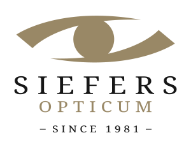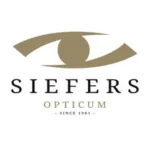- First, using an optometric instrument called a refractor, we measure everything about your eye. That is, your power, the bulge of the eye, the distance between the pupil and eye socket, and the pressure inside the eye. The first part of the eye measurement we do first per eye, and then the eyes are also measured together. All the results together form the first, so-called objective eye measurement. In many eyewear stores and chains, the measurement ends here.
- The second measurement we perform with a foropter. This device allows us to take a subjective eye measurement of your viewing experience. Again, we first measure one eye and then the two eyes together. It often turns out that lenses that exactly match your left and right eye strength independently can still produce a very uncomfortable viewing experience. Based on this measurement, we can fine-tune the strength per eye for a comfortable viewing experience as a whole.
- The third check is a practical test. For this, we put trial lenses with the measured strength in a pair of fitting glasses for you. You put them on, experience the suggested power and we carefully observe how you look through the glasses. Are you tall or short, do you turn your head a lot or do you turn your eyes to see things outside your field of vision? Viewing habits determine common viewing directions and are very important for the comfort of wearing glasses.
- The final part of the eye measurement: we take a 3D scan of your face and the curve of your desired eyeglass frame. We can also use this information to order a lens that can adjust to the frame, say, a wooden frame that cannot be adjusted properly. Then you can still experience perfect vision. We also send the measurement data to the manufacturer, read more about the possibilities of these lenses at the page about the DnEye - Scanner
Eye measurement
When it comes to your eyes and your vision, Siefers Opticum literally goes further where other opticians and optical chains stop. Not because we are pretentious or want to make our profession unnecessarily complex, but simply because not one person is the same. Sharp vision, viewing and wearing comfort depend on many more things than just the independent sharpness of both your eyes. For many people who wear glasses, most of these factors are completely unknown. Siefers Opticum is happy to open your eyes and at the same time a new world in which your glasses are no longer a necessary evil, but an asset to your daily life.
Optometry is much more than measuring the strength of your eyes
Your eyes together determine your vision, with one eye always playing a more dominant role than the other. In addition, it is important for an optometrist to know, for example, the bulge of your eyes and the distance between your two pupils. In addition to these numerical matters, your viewing behavior is very important. Do you move your head a lot or do you often see things out of the corner of your eye? Are you smaller, so you are used to looking upward, or do you tower out over most people?
A sales representative spends a lot of time in the car, an IT professional looks at screens close by. And for his or her patients, it is vital that a surgeon does not experience an image jump when he moves his gaze from the center to the edge of his lens. Lens advise is extremely important.
Our comprehensive eye measurement
Do I need glasses? Am I farsighted or nearsighted? Perhaps such questions have been playing on your mind for a while. Or maybe you need new glasses, reading glasses or prescription sunglasses. Whatever your need may be; you are welcome for a professional eye measurement in our store in Maastricht.
A standard eye measurement at Siefers Opticum will differ from what you are used to at more mainstream eyewear stores.
Our eye measurement consists of not one, not two but four measurements, checks and scans.
With us, 'check, check, double check' applies!



